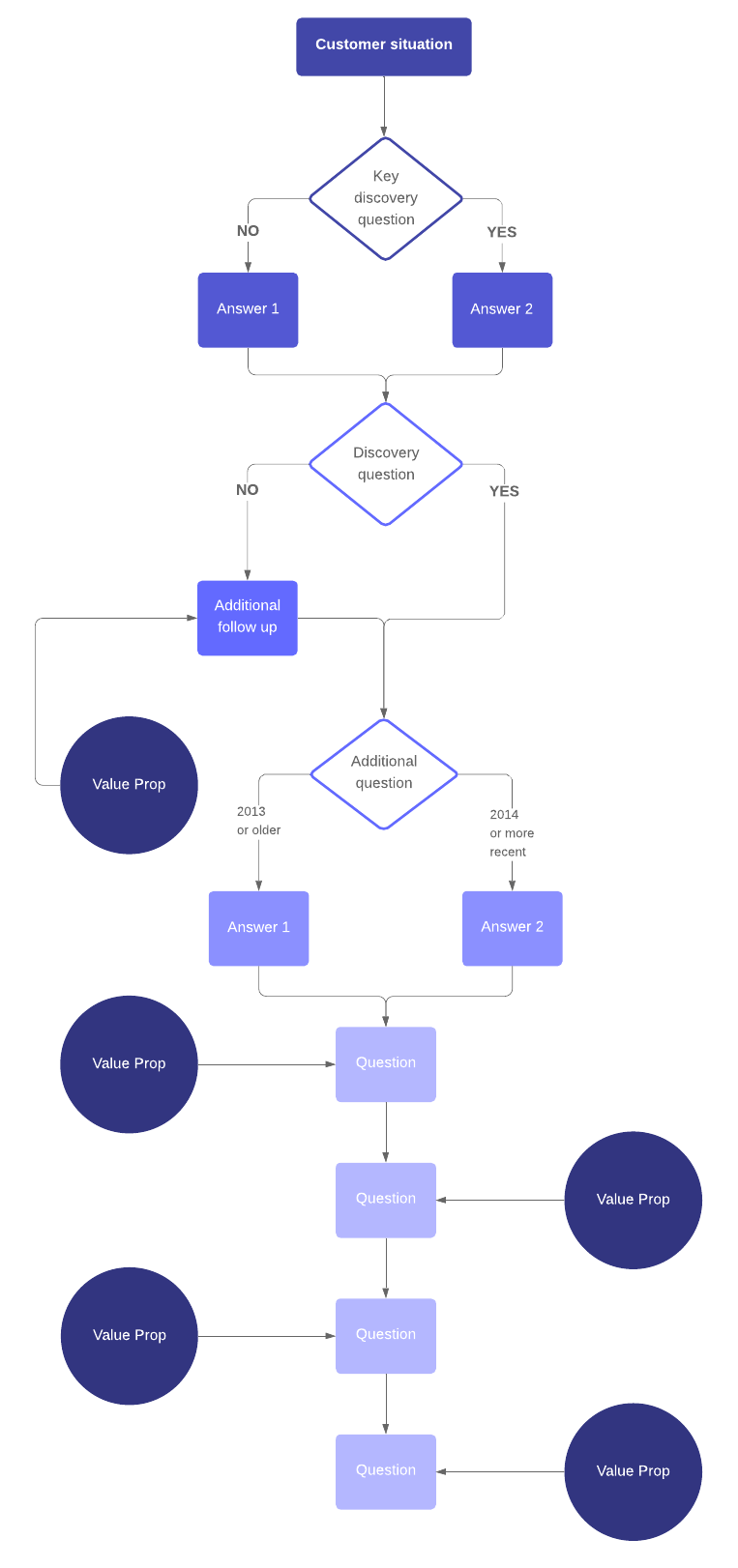
How to craft a winning sales script (and manage objections)
Lucid Content
Reading time: about 7 min
Topics:
Sales scripts are an important tool in a salesperson’s belt. When used correctly, they act as an outline to naturally guide and support conversations with prospects—especially when inevitable objections arise.
However, it’s easy to rely too heavily on a script, a mistake that can result in rote conversations, robotic-sounding sales reps, frustrated prospects, and the wrong end of a dial tone.
Keep your conversations with prospects natural and effective by following this proven outline for successful sales calls and learn to manage objections like a pro.

1. Introduce yourself
This part sounds easy, but too often sales reps get tripped up during the opening introduction. Be brief, direct, and honest. Don’t beat around the bush about who you are or why you’re calling. While being vague and avoiding your true intention to sell can buy you time, it’s annoying and disrespects your prospect’s time.
Even though the introduction is short, there are a few ways to go awry. Keep these tips in mind:
- Check the pronunciation for the prospect’s name and company. Mispronouncing their name shows a lack of care and respect, and it’s a shortcut to getting tuned out by your prospect.
- Keep the tone and topics positive. Avoid talking about traffic, bad weather, or work drudgery.
- Smile and stand up while you’re talking. Positive body language conveys confidence through your voice and helps your prospect like and trust you.
Example script:
“Hi Charisse, this is Brad from Lucidchart…”
Potential objection: "Sorry, I’m busy right now."
This is one of the most common objections during a sales call. Avoid the temptation to steamroll the prospect by charging on with your script. While you may get a few more seconds on the phone with them, it will only show them that you don’t listen and don’t respect their time.
Solution: The simplest way to manage this objection is with a quick “No problem! Is there a better time we could connect?” This answer demonstrates that you heard them and respect their time. Plus, by having them schedule the call, they feel more in control and you’ll be more likely to get their full attention.
2. Make a connection
Sales is about building relationships. But relationship building can be a daunting task when you only have a few minutes on a phone call.
So how can you bridge the gap?
The key to building rapport is to create a connection with your prospect. This might be something as simple as complimenting them on a recent business award or mentioning a shared colleague.
Research your prospect ahead of time. Where are they located? What school did they go to? Have they attended any recent conferences? Were they recently promoted?
Look for opportunities to connect with something that is personal to them or their business. This approach shows them you’re interested in them (i.e., they’re not just another robocall) and makes you more relatable.
Example script:
“Hi Charisse, this is Brad from Lucidchart.
I saw your team just won an award for ___ in Business Magazine. Congratulations!”
Potential objection: [Radio silence or a hang-up]
When sales calls (or emails) end abruptly or die without a response, it’s often because the sales rep didn’t build rapport properly. In other words, you need to give them a compelling reason to keep listening to you.
Solution: Connecting with your prospect is important, but it should never come across as inauthentic, forced, or offensive. Whatever connection you identify, make sure your questions or comments are:
- Personalized
- Unique
- Appropriate
Tailor the questions to the prospect. If possible, make them unique or unexpected. Run-of-the-mill questions tend to get automatic answers.
Asking more unique and personalized questions makes them pause and give more thoughtful and honest answers, which builds mutual trust (and doesn’t bore them to death).
Finally, never cross the line with your questions. Keep them friendly—but not too familiar or unprofessional. Inappropriate questions can quickly turn the prospect off to you and weaken your credibility.
If you build rapport on a foundation of respect and genuine interest, your prospects are much more likely to listen to you and continue a constructive conversation.
3. Explain the reason for calling
A sales call is not the time to cultivate an aura of mystery. Be clear about the purpose of your call and use this opportunity to set out an agenda for the conversation. Clarifying who you are and why you’re calling ensures all parties are on the same page so you can have an effective conversation.
For instance, you might say something like:
“Hi Charisse, this is Brad from Lucidchart.
I saw your team just won an award for ___ in Business Magazine. Congratulations!
I’m calling to see if your company would be a good fit for our Sales Solution. We’ve launched a new set of solutions designed specifically to help sales teams drive success by working visually. Do you have 10 minutes to talk?”
This approach is basically your elevator pitch. It identifies why you’re calling, how much time you plan to take, and what the conversation will be about.
Potential objection: "Sorry, I’m not interested."
Despite your best efforts, sometimes this objection is unavoidable—but it’s not insurmountable.
Solution: There could be a lot of reasons for the “I’m not interested” reply (or a variation of the same). Perhaps they’re worried about budget constraints or they don’t see a benefit from your product that they’re looking for.
The best way to combat this objection is with curiosity. If you don’t know why they’re rejecting you, you can’t address those concerns. Ask questions to drill down to the root of the issue. Once you understand their problems and hesitations, you can tailor your responses accordingly.
4. Build credibility
People buy from companies (and people) they trust. So how can you build credibility with your potential customers?
- Focus on the prospect.
- Demonstrate your expertise.
Always remember: this sale is not about you. It’s about the prospect. As you work through your pitch, focus on their needs and concerns. What are their pain points? What problems are they trying to solve? What solutions have they tried in the past? Why weren’t they successful?
Learn about their unique business situation. Listen to them. Once you understand where they’re coming from, you can tailor your proposed solution to their specific needs and requirements. By actively listening and understanding the prospect’s unique concerns, you will build greater trust and credibility.
Additionally, you can build credibility by demonstrating your expertise. Reference past success stories with your product. Use statistics and data to support your claims. Share reviews from happy customers.
All of these methods will nurture confidence in your personal expertise and the company/product’s credibility.
Example script:
“Hi Charisse, this is Brad from Lucidchart.
I saw your team just won an award for ___ in Business Magazine. Congratulations!
I’m calling to see if your company would be a good fit for our Sales Solution. We’ve launched a new set of solutions designed specifically to help sales teams drive success by working visually. Do you have 10 minutes to talk?
We’ve worked with top sales organizations like Salesforce who’ve seen a 1000% increase in sales velocity since implementing our Sales Solution.”
Potential objection: "We’re already working with [your competitor]."
This objection can stop some sales reps in their tracks. However, the beauty of this objection is that much of the legwork of selling has been done for you—they already recognize the pain points and the need for a solution.
Solution: All you have to do is drill down to what is working well and what isn’t with their current service provider. Dig deeper to learn what gaps they still have that your solution could fill. Then talk about your product and the benefits they stand to gain from making a change.
A strong sales script (and sales rebuttals) are absolutely crucial to succeed in sales. And Lucidchart can keep your sales conversations on track. Use ready-made templates to organize your sales rebuttals and objection handling scripts into easy-to-navigate flowcharts and track your sales calls throughout the lifecycle of the sale.

See additional tips for building credibility with potential customers from the start.
Read nowAbout Lucidchart
Lucidchart, a cloud-based intelligent diagramming application, is a core component of Lucid Software's Visual Collaboration Suite. This intuitive, cloud-based solution empowers teams to collaborate in real-time to build flowcharts, mockups, UML diagrams, customer journey maps, and more. Lucidchart propels teams forward to build the future faster. Lucid is proud to serve top businesses around the world, including customers such as Google, GE, and NBC Universal, and 99% of the Fortune 500. Lucid partners with industry leaders, including Google, Atlassian, and Microsoft. Since its founding, Lucid has received numerous awards for its products, business, and workplace culture. For more information, visit lucidchart.com.
